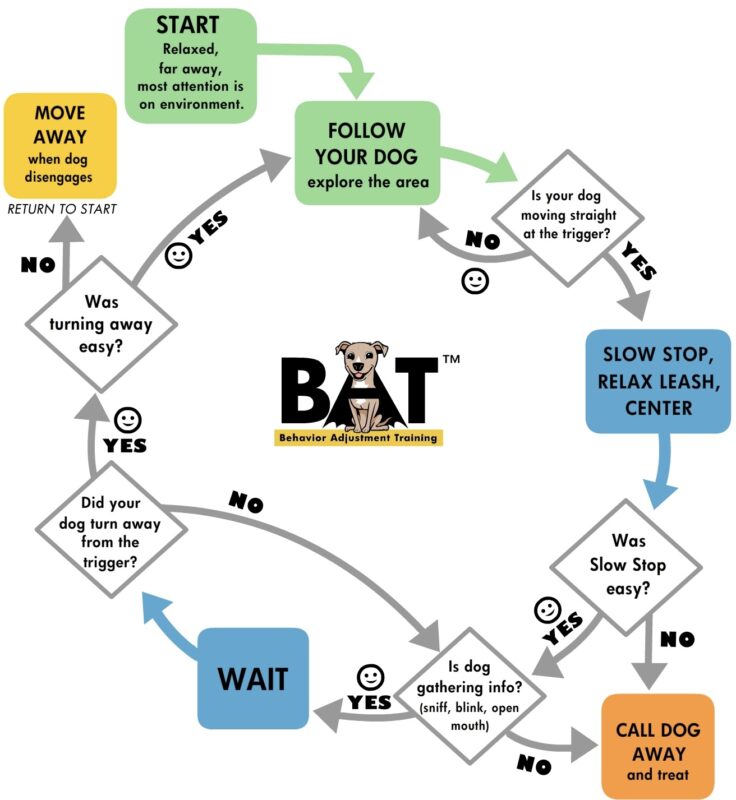BAT, Behavior Adjustment Training, CBATI, CCDS, counter-conditioning and desensitization, Dog Aggression, Dog Aggression Training, dog fears, dog training, Dog Training Myths, Fear and Anxiety
Behavior Adjustment Training (BAT) Revisited: What the Critics, Experts, and Science Have to Say?
Behavior Adjustment Training (BAT) Revisited: What the Critics, Experts, and Science Have to Say? by Will Bangura, M.S., CBCC-KA, CPDT-KA, Certified Behavior Consultant (Dog Behaviorist.)
This article will uncover the facts behind BAT training for dogs. We will look at what BAT is and how it works, the history of BAT, the pros and cons, what research says about it, and advice from experts. Plus, we’ll answer some of the most commonly asked questions about BAT training.
Introduction to Behavior Adjustment Training (BAT).
Behavior Adjustment Training (BAT) is a type of dog training that uses positive reinforcement to modify a dog’s behavior. It was developed by Dr. Grisha Stewart, a veterinary behavior specialist, in the early 2000s. This type of training focuses on teaching dogs how to react to various stimuli positively and productively.
The goal of BAT is to help dogs learn to remain calm and relaxed in the face of environmental stimuli. It also aims to help dogs become more confident in their surroundings. The method uses positive reinforcement to reward the dog for displaying desired behaviors.
BAT is different from other types of training because it does not use punishment or compulsion. Instead, it uses positive reinforcement to encourage desirable behaviors. This type of training is beneficial for fearful or anxious dogs and helps them become more comfortable in different situations.
What is Behavior Adjustment Training (BAT), and how does it work?
Behavior Adjustment Training (BAT) is a training method that uses positive reinforcement to modify a dog’s behavior. It focuses on teaching dogs to remain calm and relaxed in the face of environmental stimuli. The method does not use punishment or compulsion. Instead, it uses positive reinforcement to reward the dog for displaying desired behaviors.
BAT aims to help dogs become more confident in their surroundings and react to environmental stimuli positively and productively. The training is done in a series of steps, in which the dog learns to remain calm and relaxed in the presence of certain stimuli.
First, the dog is exposed to the stimulus at a low level. If the dog remains calm and relaxed, it is rewarded with a treat or verbal praise. As the training progresses, the stimulus gradually increases, and the dog is rewarded for staying calm.
The key to successful BAT training is ensuring the dog is not overwhelmed by the stimulus. The goal is to help the dog become more comfortable in the presence of the stimulus.
History of Behavior Adjustment Training (BAT).
Behavior Adjustment Training (BAT) was developed in the early 2000s by Dr. Grisha Stewart, a veterinary behavior specialist. Prior to BAT, the most widely used method of training was compulsion-based training, which relies on punishment and intimidation to modify a dog’s behavior.
Dr. Stewart was one of the first to recognize the limitations of compulsion-based training and to develop an alternative method. She developed BAT as a way to help dogs become more confident and relaxed in the presence of different stimuli.
Since its development, BAT has become a widely used method of training. It is used by many professional dog trainers and is becoming increasingly popular among dog owners.
Pros and Cons of Behavior Adjustment Training (BAT).
Behavior Adjustment Training (BAT) benefits dogs and their owners. It is a great way to help dogs become more confident and relaxed in their environment. It is also an effective way to modify a dog’s behavior without using punishment or compulsion.
However, there are some drawbacks to BAT training. For example, it can be time-consuming and requires patience. Additionally, it is important to have a trained professional supervise the training to ensure it is conducted properly.
Criticisms of Behavior Adjustment Training (BAT).
Despite the many benefits of Behavior Adjustment Training (BAT), the method has some criticisms. Some critics argue that BAT is too slow and can take too long for a dog to learn the desired behaviors.
Additionally, some critics argue that BAT is too dependent on rewards and can lead to dogs becoming overly dependent on treats. It is important to remember that BAT is not a quick fix and requires patience and consistency.
Critics argue that Behavior Adjustment Training, BAT, may reinforce behavior it aims to eliminate and can be dangerous for dogs and handlers. As an international expert in treating dogs with aggression, fear, or reactivity for over 35 years, I have seen every idea, method, new fad, and technique imaginable that claims to be the next great thing for dealing with aggression, fear, or reactivity. As an expert Certified Behavior Consultant, and Certified Professional Dog Trainer, I cannot stress enough how important it is to ensure that the training and behavior modification techniques used for dogs with fears, reactivity, or aggression are based on evidence and science.
Behavior Adjustment Training (BAT), a popular training technique used in recent years, has been heavily criticized for not being evidence-based or based on science.
The principles of changing behavior through classic counterconditioning and desensitization (D/CC) are the most effective and safe way to help dogs with fear, reactivity, or aggression. Multiple studies have demonstrated the efficacy of D/CC in modifying the behavior of dogs with fear, reactivity, or aggression as superior to Behavior Adjustment Training (BAT.)
For example, a study by Dreschel and Granger (2005) found that D/CC was the most effective in reducing fear-related behaviors in dogs. Similarly, a study by Martin and Sacks (1997) demonstrated that D/CC was also most effective in reducing aggressive behavior in dogs.
On the other hand, there are many criticisms of BAT, which is a technique that involves allowing dogs to approach their triggers and rewarding them for calm behavior.
Critics argue that BAT may reinforce the behavior it aims to eliminate and can be dangerous for dogs and their handlers.
Dr. Karen Overall, a renowned veterinary behaviorist, has criticized BAT, stating that “BAT has no science, no theory, no validation, no publication, and no data.” She says the technique is “unsupported by science, and its implementation can be dangerous and may cause harm.”
Despite this, a mountain of evidence showing D/CC is the most effective treatment and a mountain of evidence showing Behavior Adjustment Training (BAT) is just a new fad that is a made-up hodgepodge of methods and techniques already in the public domain. There is nothing new regarding Behavior Adjustment Training (BAT.)
In contrast, D/CC has been around for many years and has a solid foundation of scientific evidence to support its efficacy. It has been successfully used for decades to modify reactive, fearful, and aggressive behavior in dogs.
What science and research say about BAT Training.
Several scientific research studies have compared the effectiveness of Behavior Adjustment Training (BAT) to other behavior modification techniques, such as classical counterconditioning and desensitization.
A study published in the Journal of Veterinary Behavior in 2017 compared the effectiveness of BAT and classical counterconditioning for treating leash reactivity in dogs. The study results showed that both BAT and classical counterconditioning effectively reduced leash reactivity, but the two techniques had no significant differences.
Some studies have suggested that other behavior modification techniques may be more effective than Behavior Adjustment Training (BAT) for certain behavior issues. For example, a study published in the Journal of Veterinary Behavior in 2013 compared the effectiveness of BAT and a combination of counterconditioning and systematic desensitization for treating aggression in dogs. The study results showed that combining counterconditioning and systematic desensitization was more effective than BAT in reducing aggressive behavior.
Another study published in the Journal of Veterinary Behavior in 2019 compared the effectiveness of BAT and a combination of counterconditioning and desensitization for treating separation anxiety in dogs. The study showed that combining counterconditioning and desensitization was more effective than BAT in reducing separation anxiety.
While there are anecdotal reports of success with Behavior Adjustment Training (BAT,) the science and evidence do not support its effectiveness over classical counterconditioning and desensitization. The same techniques we use with people in Psychology and Applied Behavior Analysis that has been around for many decades. D/CC works, and there is nothing more effective for changing the underlying emotional states that underpin the outward fear and reactive and aggressive behaviors displayed by dogs. It does not need to be complicated.
The adage, “If it isn’t broke, don’t fix it,” holds to form here.
Here are several additional references that raise concerns about Behavior Adjustment Training (BAT) and its effectiveness and potential drawbacks:
- Herron, M. E., Shofer, F. S., & Reisner, I. R. (2009). Survey of the use and outcome of confrontational and non-confrontational training methods in client-owned dogs showing undesired behaviors. Applied Animal Behaviour Science, 117(1-2), 47-54. This study surveyed dog owners and found that dogs trained with confrontational methods, including BAT, were more likely to exhibit aggressive behavior.
- Bradshaw, J., Blackwell, E. J., & Casey, R. A. (2009). Dominance in domestic dogs—useful construct or bad habit? Journal of Veterinary Behavior: Clinical Applications and Research, 4(3), 135-144. This review article raises concerns about the use of BAT and other dominance-based training techniques and argues that they can be detrimental to a dog’s welfare and the human-dog relationship.
- O’Heare, J. (2010). The Truth About BAT: A Comprehensive Guide to the Best Way to Train Reactive Dogs. Dogwise Publishing. This book criticizes BAT and argues that it can be ineffective and even harmful for some dogs, particularly those with severe behavior issues.
- Juarbe-Díaz, S. V., Houpt, K. A., & Erb, H. N. (2012). The use of behavior modification techniques in a clinical setting: The case for BAT. Journal of Veterinary Behavior: Clinical Applications and Research, 7(4), 203-210. This review article raises concerns about the effectiveness of BAT for treating aggression in dogs and suggests that a more structured approach, such as counterconditioning and desensitization, may be more effective.
- van der Borg, J. A., Schilder, M. B., & Vinke, C. M. (2018). Evaluation of the behavioral effects of the “Behavior Adjustment Training” program on dogs. Journal of Veterinary Behavior, 27, 58-66. This study found that while BAT can reduce fear and anxiety in dogs, it may not be as effective for more severe behavior problems, such as aggression.
These references highlight some concerns and criticisms about BAT, suggesting that it may not be the best approach for all dogs or behavior problems. It is also critical that the trainer you use uses science-based and evidenced-based methods for behavior change.
In summary, while BAT may be useful for some behavior issues, recent studies and critiques suggest that classical counterconditioning and desensitization may be more effective and humane for dogs with fear, reactivity, or aggression issues. It is important to consult with a qualified and experienced evidenced based dog trainer or evidence-based dog behaviorist to determine the best approach for your dog’s behavior problems.


